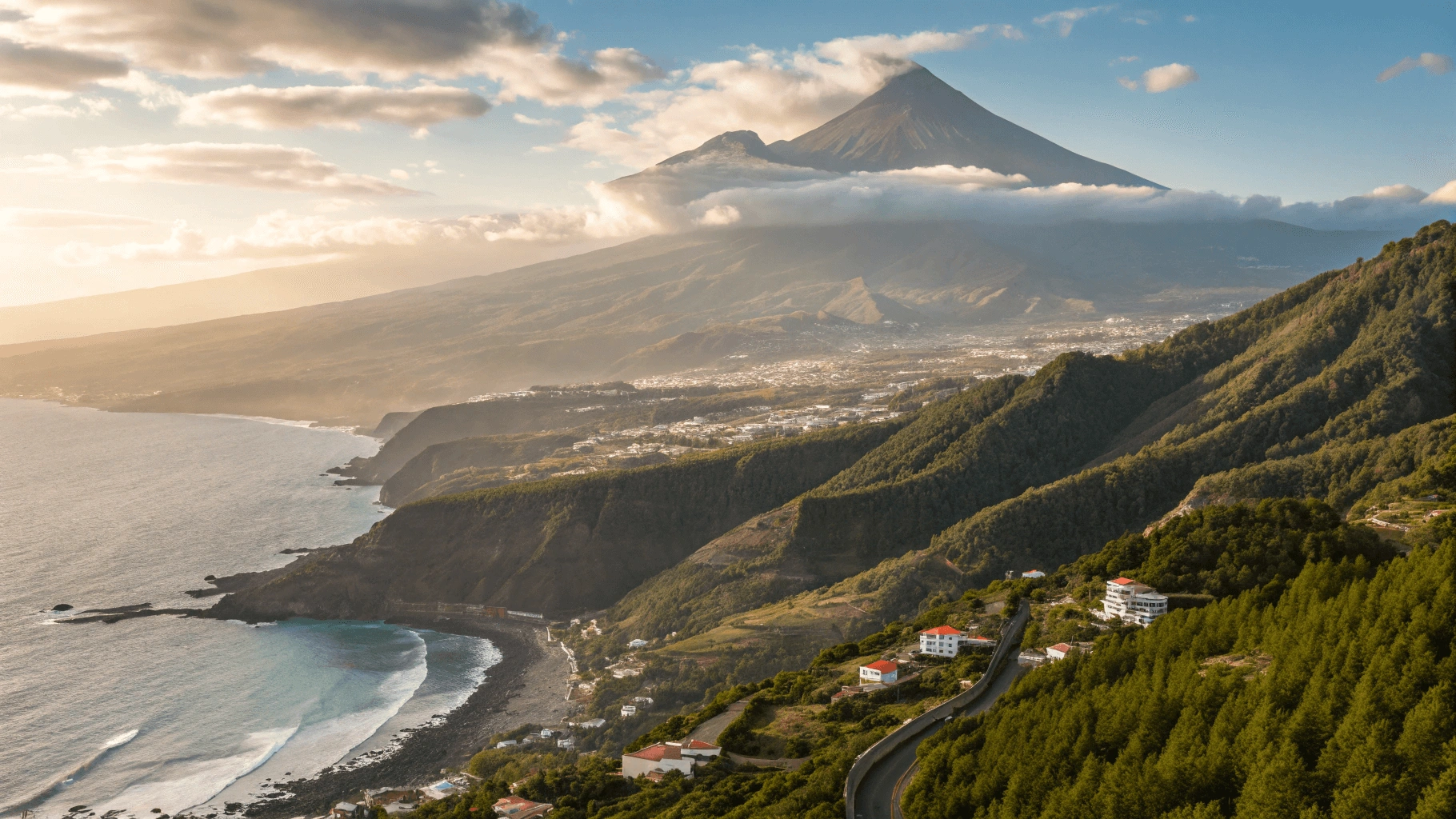Are you dreaming of volcanic landscapes, year-round sunshine, and pristine beaches? Look no further than Tenerife, the largest of Spain’s Canary Islands. Whether you’re seeking adventure, relaxation, or cultural immersion, this comprehensive guide to travel to tenerife spain Tenerife will help you plan the perfect trip to this diverse Atlantic paradise.
Table of Contents
Why Visit Tenerife?
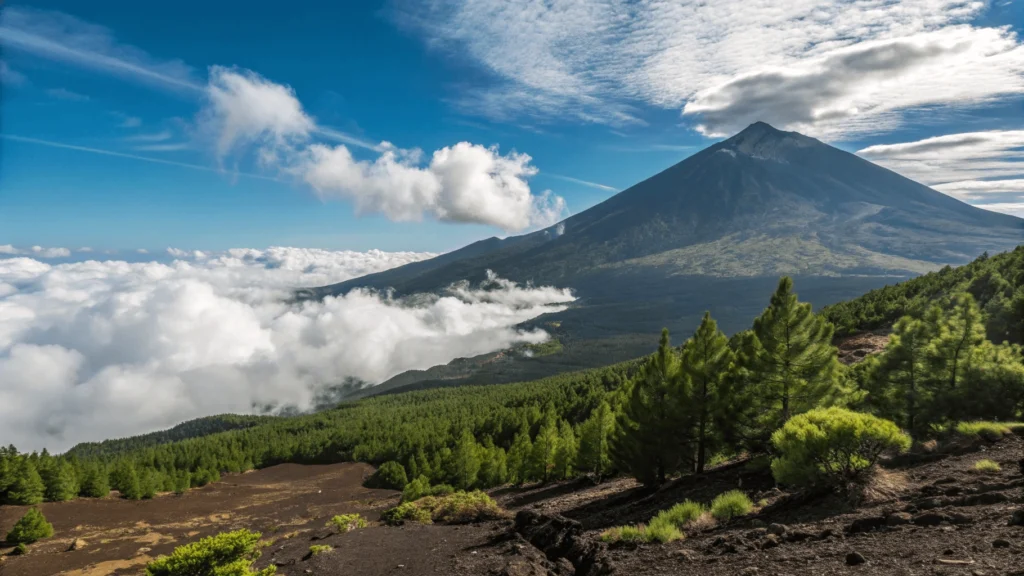
Tenerife defies expectations at every turn. While many associate it solely with package holidays and beach resorts, the island offers an astonishing variety of experiences within its 2,034 square kilometers.
Beyond the Obvious: Tenerife’s Unique Selling Points
- Microclimates Galore: Tenerife hosts 12 distinct microclimates, allowing you to experience lush forests, desert-like landscapes, and balmy beaches all in a single day. The north is greener with subtropical vegetation, while the south offers more sunshine and arid landscapes.
- UNESCO Heritage: The historic city of La Laguna is a UNESCO World Heritage site, offering perfectly preserved colonial architecture and a glimpse into the island’s rich history.
- Astronomical Wonder: Tenerife boasts some of the clearest skies in Europe, making it a premier stargazing destination. The Teide Observatory is one of the world’s most important astronomical research centers.
- Endemic Species: The island is home to unique flora and fauna found nowhere else on Earth, including the Tenerife lizard and the Teide violet, which grows at high altitudes on the volcano.
- Wine Production: Tenerife’s volcanic soil produces distinctive wines from ancient grape varieties that survived the phylloxera plague that devastated European vineyards. “travel to tenerife spain”
Debunking Tenerife Myths
| Myth | Reality |
|---|---|
| “Tenerife is just a package holiday destination” | While the south has resorts, the island offers authentic cultural experiences, especially in the north and rural areas |
| “It’s only for beach holidays” | Tenerife has world-class hiking, stargazing, surfing, cultural sites, and gastronomy |
| “It’s overrun with tourists” | Many areas remain untouched by mass tourism, particularly in rural regions and the stunning Anaga mountains |
| “The food is just international cuisine for tourists” | Traditional Canarian cuisine thrives across the island, with unique local dishes and ingredients |
| “It’s too hot in summer” | The island’s temperature rarely exceeds 28°C (82°F) due to trade winds and the Atlantic influence |
When to Go: Month-by-Month Guide to Tenerife
Tenerife truly deserves its nickname “Island of Eternal Spring” with year-round pleasant temperatures, but each season offers different advantages. “travel to tenerife spain”

Winter (December-February)
- Weather: 17-22°C (63-72°F), occasional rain in the north, sunny in the south
- Crowds: Peak season, especially during Christmas and New Year
- Prices: Highest of the year, especially accommodation
- Events:
- Santa Cruz Carnival (February/March) – second largest in the world after Rio
- Almond blossom season in Santiago del Teide (February)
- Ideal for: Winter sun, hiking, cultural experiences, whale watching
Spring (March-May)
- Weather: 18-24°C (64-75°F), increasingly stable weather
- Crowds: Moderate, with Easter being busier
- Prices: Mid-range, dropping after Easter
- Events: “travel to tenerife spain”
- Holy Week processions (March/April)
- Corpus Christi flower carpets in La Orotava (usually May/June)
- Romería de San Marcos in Tegueste (April)
- Ideal for: Hiking, photography (wildflowers bloom), cultural experiences
Summer (June-August)
- Weather: 23-28°C (73-82°F), virtually no rain, occasional calima (dust from Sahara)
- Crowds: Busy, particularly in August when Spanish mainlanders vacation
- Prices: High, especially August
- Events: “travel to tenerife spain”
- Night of San Juan beach bonfires (June 23)
- Virgen del Carmen maritime processions (July)
- Romería de San Roque in Garachico (August)
- Ideal for: Beach holidays, water sports, stargazing
Autumn (September-November)
- Weather: 20-26°C (68-79°F), occasional rain starting in October
- Crowds: Low, except around UK half-term holidays
- Prices: Lowest of the year (except half-term weeks)
- Events: “travel to tenerife spain”
- Wine harvest festivals (September)
- All Saints’ Day celebrations (November 1)
- San Andrés wine tasting celebrations (November 29-30)
- Ideal for: Hiking, wine tourism, authentic experiences
Shoulder Season Benefits (May-June and September-October)
- Better hotel rates (20-30% lower than peak season)
- Pleasant temperatures without summer heat
- Less crowded attractions and beaches
- More authentic local experiences as fewer tourists are present
- Ideal sea temperatures for swimming
Getting There
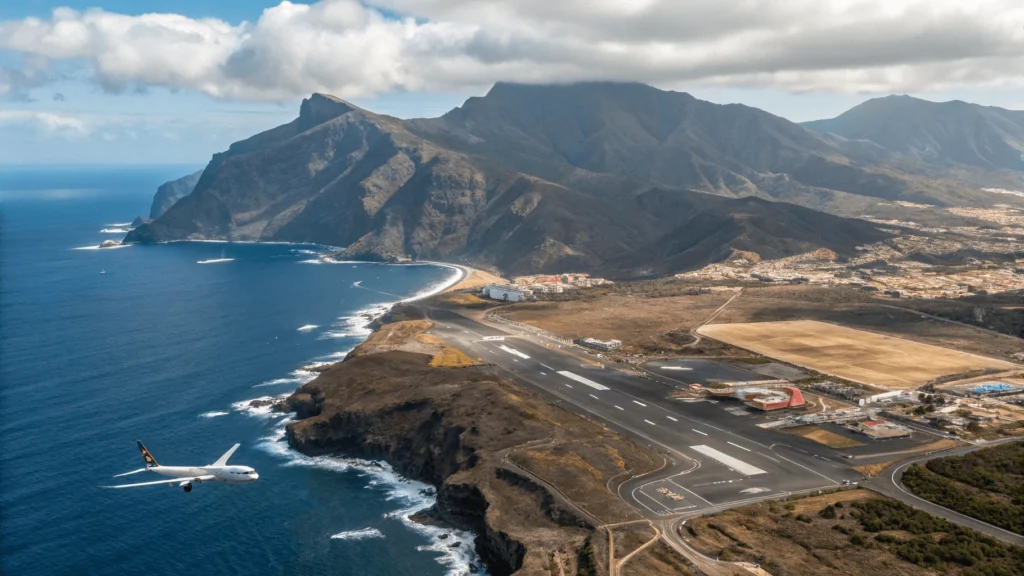
Flights to Tenerife
Tenerife has two airports:
Tenerife South Airport (TFS – Reina Sofia)
- Primary airport for tourists, handling 70% of all traffic
- Located near popular southern resorts
- Major airlines: Ryanair, EasyJet, TUI, British Airways, Iberia, Lufthansa
- Better connected to European destinations
- More frequent winter connections
Tenerife North Airport (TFN – Los Rodeos)
- Primarily serves domestic routes and connections to mainland Spain
- Located near Santa Cruz and La Laguna
- Major airlines: Iberia, Air Europa, Binter Canarias, Vueling
- Better for those staying in the northern part of the island
- More connections to other Canary Islands
Booking Tips: “travel to tenerife spain”
- Book 3-5 months in advance for best prices
- Midweek flights (Tuesday-Thursday) are typically 15-25% cheaper
- Consider package deals in the off-season for substantial savings
- Use flight comparison tools that include smaller carriers
- Check both airports as prices can vary significantly
Ferries to Tenerife
While most visitors arrive by air, ferries offer a scenic alternative and the ability to bring your own vehicle.
Main Routes: “travel to tenerife spain”
- From mainland Spain: Cádiz or Huelva to Santa Cruz de Tenerife (30-36 hours)
- From other Canary Islands:
- Gran Canaria to Santa Cruz (80-120 minutes)
- La Gomera to Los Cristianos (40-60 minutes)
- La Palma to Santa Cruz (2.5-4 hours)
- El Hierro to Los Cristianos (2-3 hours via La Gomera)
Ferry Companies:
- Naviera Armas: More routes, larger ships, café/restaurant options
- Fred Olsen Express: Faster catamarans, slightly higher prices
- Trasmediterránea: Primarily for mainland Spain connections
Pros of Ferry travel to tenerife spain:
- Bring your own vehicle
- No luggage restrictions
- More scenic experience
- Can move between islands easily
- Often cheaper for families or groups
Cons of Ferry travel to tenerife spain:
- Time-consuming compared to flights
- Can be affected by rough seas
- Limited departure times
- Basic amenities on shorter routes
Inter-island Travel
Flights: “travel to tenerife spain”
- Operated primarily by Binter Canarias and Canaryfly
- 30-45 minute connections to all other Canary Islands
- Usually depart from Tenerife North Airport
- Book at least 3-4 weeks ahead for better rates
Ferries: “travel to tenerife spain”
- More economical option for nearby islands
- More flexible schedule to La Gomera
- Can take vehicles to all islands
- More resilient to weather than small inter-island aircraft
Getting Around Tenerife

Car Rental
Having your own vehicle provides ultimate flexibility for exploring Tenerife’s diverse landscapes.
Recommended Companies:
- Local: Cicar, AutoReisen, PlusCar
- International: Sixt, Hertz, Europcar
Typical Costs: “travel to tenerife spain”
- Economy car: €25-35/day in low season, €40-60/day in high season
- Mid-size car: €35-50/day in low season, €55-75/day in high season
- SUV (recommended for mountain areas): €50-70/day in low season, €80-120/day in high season
Insurance Tips:
- Decline rental company CDW and instead use credit card coverage or third-party insurance
- Watch for fuel policies – “full-to-full” is best
- Document any pre-existing damage with photos
- Consider excess insurance from a third party before arrival (much cheaper)
Driving Tips: “travel to tenerife spain”
- Drive on the right side of the road
- Mountain roads can be narrow with hairpin turns
- TF-1 motorway connects south to Santa Cruz
- TF-5 connects Santa Cruz to Puerto de la Cruz
- Allow extra time for mountain routes like Masca or Teide
- Free parking is available in many areas outside major cities
Parking Nuances: “travel to tenerife spain”
- Blue zones (zona azul) are paid parking, usually €0.60-€1.20/hour
- Yellow lines mean no parking
- White lines typically indicate free parking
- Underground parking garages are common in cities (€1-2/hour)
- Resort areas often have free parking lots on the periphery
Public Transport
Tenerife’s public bus system (TITSA) is comprehensive, affordable, and connects most tourist sites.
TITSA Bus Network:
- Green buses cover the entire island
- Main hub stations in Santa Cruz, Puerto de la Cruz, and Los Cristianos, Discover more about Santa Cruz de Tenerife’s attractions and why it’s considered an ideal winter destination. “travel to tenerife spain”
- Buses are called “guaguas” locally (pronounced “wah-wahs”)
Key Routes for Tourists: “travel to tenerife spain”
- 110/111: Southern resorts to Santa Cruz
- 343: Los Cristianos to Teide National Park
- 348: Puerto de la Cruz to Teide National Park
- 410: Los Cristianos to Los Gigantes
- 420: Los Cristianos to Santa Cruz (via airport)
- 711: Santa Cruz to Puerto de la Cruz
Bono Card Information:
- Rechargeable travel card offering 20-50% discount on fares
- Available at bus stations and some tobacconists (€2 for the card)
- Can be loaded with €5-€50
- Can be shared among multiple travelers
- Also valid on trams in Santa Cruz
TITSA App Usage: “travel to tenerife spain”
- Real-time bus tracking
- Journey planning
- Timetables and route maps
- Service disruption alerts
- Mobile ticket purchase options
Taxis and Ride-Sharing
Taxis: “travel to tenerife spain”
- White vehicles with red stripe and taxi sign
- Metered fares with fixed rates between certain points
- Approximately €1.40-€1.70 per kilometer
- Airport to southern resorts: €25-35
- Additional charges for luggage, night service, and holidays
- Most accept credit cards, but confirm before boarding
Ride-Sharing:
- Uber and Lyft are not currently operating in Tenerife
- Cabify operates in limited areas around Santa Cruz
- Local taxi apps like PideTaxi offer similar convenience
Tours vs. Independent Travel
Organized Tours:
- Pros: Convenience, expert guides, social experience, transport included
- Cons: Fixed schedules, limited customization, touristy experience
- Best for: Teide stargazing, whale watching, wine tours, La Gomera day trips
Independent travel to tenerife spain:
- Pros: Flexibility, authentic experiences, usually cheaper, go at your own pace
- Cons: Requires planning, navigation, language barriers
- Best for: Beach days, hiking, exploring small towns, local cuisine discovery
Recommended Local Tour Operators:
- Volcano Teide Experience (for Teide tours)
- Teno Activo (for hiking and adventure)
- White Tenerife (for water activities)
- Tenerife Host (for private guided tours)
- El Cardón (for nature experiences) “travel to tenerife spain”
Where to Stay in Tenerife

Tenerife’s diverse regions offer dramatically different experiences. Choose wisely based on your interests and priorities.
South vs. North Comparison
| Southern Tenerife | Northern Tenerife |
|---|---|
| Sunny, arid climate with minimal rain | Greener, occasional rain, lush vegetation |
| More tourist infrastructure | More authentic Canarian atmosphere |
| English widely spoken | Spanish more predominant |
| Larger beaches, often man-made | Smaller, natural black sand beaches |
| Purpose-built resorts | Historic towns and cities |
| Nightlife and entertainment focus | Cultural and gastronomy focus |
| Flatter terrain | More dramatic, rugged landscapes |
Coastal vs. Inland
Coastal Benefits:
- Sea views and beach access
- More dining options and amenities
- Better public transport connections
- More nightlife and entertainment
- Often warmer and more consistent weather
Inland Benefits: “travel to tenerife spain”
- More authentic Canarian experience
- Lower prices (20-40% less than coastal properties)
- Cooler temperatures in summer
- Quieter, more relaxed atmosphere
- Dramatic mountain views
- Better hiking access
Detailed Region Breakdown
Costa Adeje (South)
- Best for: Luxury travelers, families, beach lovers
- Accommodation types: 4-5 star hotels, luxury villas
- Highlights: Upscale shopping, high-end restaurants, Siam Park
- Beaches: Playa del Duque, Playa Fañabé, La Caleta
- Price range: €€€-€€€€
Los Cristianos/Playa de las Américas (South)
- Best for: Budget travelers, nightlife seekers, British tourists
- Accommodation types: Apartment complexes, mid-range hotels
- Highlights: Shopping centers, bars, restaurants, water sports
- Beaches: Las Vistas, Troya, Los Cristianos
- Price range: €-€€€
Puerto de la Cruz (North)
- Best for: Mature travelers, culture enthusiasts, longer stays
- Accommodation types: Traditional hotels, boutique guesthouses
- Highlights: Lago Martiánez pools, Botanical Gardens, Loro Parque
- Beaches: Playa Jardín, Playa Martiánez
- Price range: €€-€€€
Santa Cruz de Tenerife (Northeast)
- Best for: City lovers, shopping enthusiasts, authentic experiences
- Accommodation types: City hotels, apartments
- Highlights: Museums, shopping, Carnival, architecture
- Beaches: Las Teresitas, Las Gaviotas
- Price range: €€-€€€ “travel to tenerife spain”
La Laguna (Northeast Inland)
- Best for: History buffs, university atmosphere, authenticity
- Accommodation types: Historic buildings, boutique hotels
- Highlights: UNESCO old town, churches, museums
- Price range: €€-€€€
Masca/Rural Northwest
- Best for: Nature lovers, hikers, solitude seekers
- Accommodation types: Rural houses, small guesthouses
- Highlights: Dramatic scenery, hiking trails, stargazing
- Price range: €€-€€€
El Médano (Southeast)
- Best for: Wind sports enthusiasts, young travelers, laid-back atmosphere
- Accommodation types: Apartments, surf houses
- Highlights: Windsurfing, kitesurfing, volcanic beaches
- Price range: €-€€
Accommodation Types
Hotels: “travel to tenerife spain”
- Range from budget to luxury (€60-500/night)
- All-inclusive options common in south
- Best for short stays and those who value amenities
- Often include pools, restaurants, entertainment
Apartments:
- Self-catering facilities
- More space than hotel rooms
- Weekly rates often better value (€350-1000/week)
- Flexibility for meals and schedules
Villas:
- Private pools and gardens
- Ideal for families or groups
- Range from modest to ultra-luxury
- Often require car rental due to locations
- €700-3000/week depending on size and location
Rural Houses:
- Traditional Canarian architecture
- Located in villages and countryside
- Authentic experience
- Often feature gardens with fruit trees
- €70-150/night
Top Things to Do & See in Tenerife
Beaches “travel to tenerife spain”
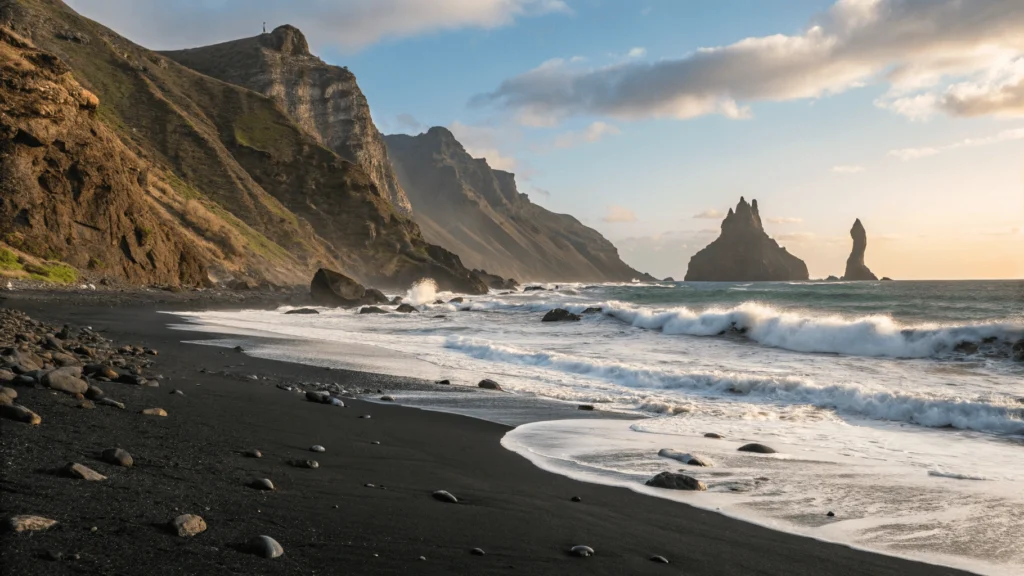
Tenerife offers everything from golden tourist hotspots to hidden black sand coves.
Famous Beaches: “travel to tenerife spain”
- Playa de las Teresitas (Santa Cruz): Golden sand imported from the Sahara, palm trees, local atmosphere
- Playa de las Américas: Tourist central with water sports and amenities
- Playa del Duque (Costa Adeje): Upscale beach with fine golden sand
- Playa Jardín (Puerto de la Cruz): Black sand beach designed by artist César Manrique
Hidden Gems:
- Playa de Benijo (Anaga): Wild, dramatic black sand beach with rock formations
- Playa Bollullo (La Orotava): Natural black sand cove accessible by foot
- Playa de Antequera: Remote beach accessible only by boat or difficult hike
- Playa Abama: Semi-private beach near the luxury hotel, accessible to public
Family-Friendly Beaches:
- Playa las Vistas: Calm waters, facilities, lifeguards
- Playa Fañabé: Shallow entry, restaurants, shade
- El Médano: Wide open spaces, gentle slope (though watch for wind)
Surfing and Water Sports Beaches:
- El Socorro (Los Realejos): Consistent surf breaks
- La Caleta (Costa Adeje): Diving and snorkeling
- El Médano: World-famous windsurfing and kitesurfing
- Las Américas: Surf schools and equipment rental
Teide National Park
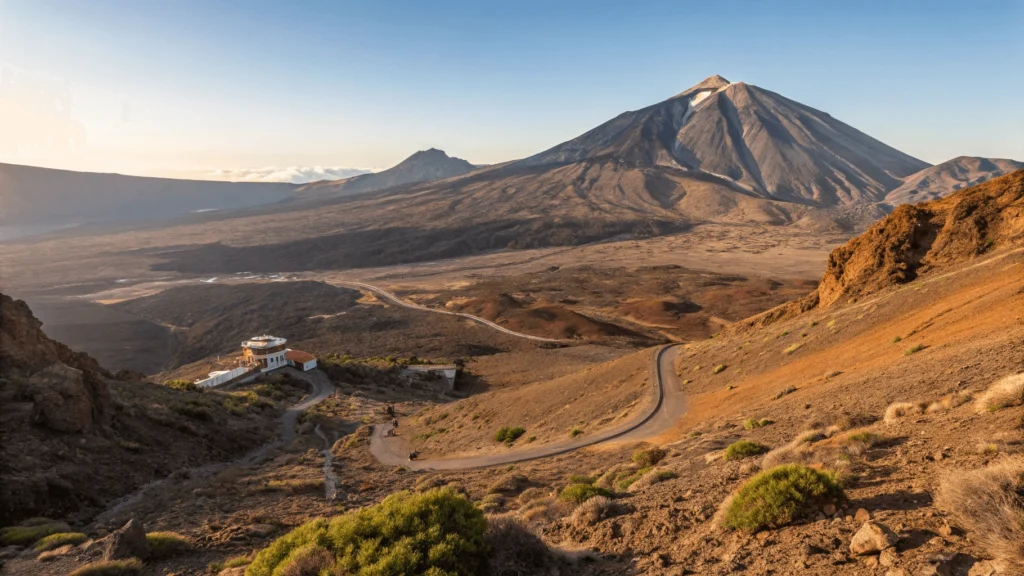
Spain’s most visited national park centers around Mt. Teide, Spain’s highest peak (3,718m) and the world’s third-tallest volcanic structure from its base.
Permits and Access:
- The summit requires a free permit from www.reservasparquesnacionales.es
- Book 2-3 months in advance for peak season
- Morning permits (9am-11am) offer best visibility
- Alternative: stay overnight at Altavista Refuge (requires booking)
- No permit needed if you only visit by cable car without hiking to summit
Cable Car Information:
- Operating hours: 9am-5pm (last ascent 4pm)
- Adult ticket: €38 return (2025 prices)
- Book online for 10% discount and to avoid queues
- Closes in strong winds or bad weather
- Takes you to 3,555m (not the summit)
Hiking Routes: “travel to tenerife spain”
- Montaña Blanca to Peak (Permit required): 8km, 5-6 hours, challenging
- Roques de García Loop: 3.5km, 2 hours, moderate
- Siete Cañadas Path: 16km, 5-6 hours, moderate
- Narices del Teide: 2km, 1 hour, easy
- Samara Trail: 5km, 2-3 hours, moderate
Stargazing: “travel to tenerife spain”
- One of the world’s best locations for astronomy
- Sunset-stargazing tours available (€60-80)
- Bring warm clothes (temperatures drop dramatically)
- Full moon nights reduce visibility of stars
- Best spots: Parador, Montaña Blanca, Minas de San José
Anaga Rural Park
This ancient laurel forest in the northeastern peninsula feels like stepping into prehistoric times.
Hiking Trails:
- Cruz del Carmen to Chinamada: 5km, 3 hours, views of ravines
- El Batán to Taganana: 8km, 4 hours, descending to coastal village
- Benijo Circular Route: 6km, 3 hours, spectacular coastal views
- Las Vueltas: 4.5km, 2 hours, dense laurel forest
Viewpoints: “travel to tenerife spain”
- Mirador Cruz del Carmen: Forest panoramas, visitor center
- Mirador Cabezo del Tejo: Coastline views
- Mirador de Amogoje: Mountains meeting ocean
- Mirador Pico del Inglés: Views of Santa Cruz and Las Teresitas
Villages to Visit:
- Taganana: Coastal hamlet with excellent seafood
- Chamorga: The end of the road in eastern Anaga
- Chinamada: Cave houses still inhabited today
- Benijo: Wild beaches and dramatic coastline
Masca Valley
This remote valley and village was once only accessible by foot or donkey path.
Hiking the Masca Gorge:
- Currently requires guide (environmental protection)
- Book with authorized companies (€45-60)
- 3-4 hours one-way to the beach
- Return by boat to Los Gigantes (included in most tours)
- Moderate-difficult with some scrambling “travel to tenerife spain”
Driving to Masca:
- Spectacular winding road (TF-436)
- Not for nervous drivers or those afraid of heights
- Allow plenty of time (road is slow)
- Limited parking in village (arrive early)
- Consider public bus (less stressful)
Boat Trips:
- Los Gigantes to Masca Beach (€20-30)
- Whale watching combinations available
- Not available in rough seas
- Book 1-2 days in advance in high season
Siam Park & Loro Parque
Two of Tenerife’s most popular attractions, both owned by the same company.
Siam Park (Water Park):
- Europe’s largest water park
- Thai-themed with multiple attractions
- Popular rides: Tower of Power, Singha, The Dragon
- Fast-track options available during peak season
- €40 adult entry (2025 price)
- Best to arrive at opening or after 2pm to avoid crowds
Loro Parque (Zoo and Marine Park):
- Award-winning zoological park
- Notable attractions: Orca show, dolphin show, penguin habitat
- Conservation programs and education center
- €40 adult entry (2025 price)
- Allow full day to see everything
- Free train from Puerto de la Cruz center “travel to tenerife spain”
Tips for Both Parks:
- Combo tickets save 10-15%
- Book online for discounts
- Free buses from major tourist areas
- Food is expensive inside – consider packed lunch
- Lockers available for valuables
Cities & Towns
Santa Cruz de Tenerife:
- Capital city with urban sophistication
- Highlights: Auditorio de Tenerife, Plaza de España, TEA art space
- Shopping: El Corte Inglés department store, Calle Castillo pedestrian zone
- Culture: Carnival Museum, Municipal Museum of Fine Arts
- Food: Great tapas bars around Calle La Noria
La Laguna: “travel to tenerife spain”
- UNESCO World Heritage Site
- Highlights: Cathedral, Church of La Concepción, traditional courtyards
- Culture: History & Anthropology Museum, Science Museum
- Atmosphere: University town, lively evening scene
- Architecture: Perfectly preserved colonial buildings
Puerto de la Cruz:
- Traditional tourist town in the north
- Highlights: Lago Martiánez pool complex, Botanical Gardens
- Culture: Casa de la Aduana, fishing harbor
- Food: Excellent seafood restaurants
- Shopping: Traditional Canarian products
Garachico: “travel to tenerife spain”
- Town rebuilt after volcanic destruction
- Highlights: Natural rock pools, colonial architecture
- History: Castillo de San Miguel, ex-convent of San Francisco
- Atmosphere: Authentic, peaceful, historical
La Orotava:
- Elegant historical town
- Highlights: Casa de los Balcones, botanical gardens
- Culture: Traditional architecture, beautiful churches
- Events: Corpus Christi flower carpets (May/June)
- Views: Valley and ocean panoramas
Whale & Dolphin Watching
Tenerife’s channel between the island and La Gomera is one of the world’s best cetacean-watching locations.
Ethical Tour Considerations:
- Choose operators certified with Blue Boat flag
- Avoid companies guaranteeing sightings (may harass animals)
- Larger, stable boats cause less environmental impact
- Tours that include marine biologists/educators are better
- Respect approach distances and animal behavior
Tour Types: “travel to tenerife spain”
- Large boat excursions: More stable, facilities on board, less intimate (€30-45)
- Sailing catamarans: Eco-friendly, often include swimming stops (€50-70)
- RIB boats: Faster, closer to water, more thrilling (€60-80)
- Private charters: Customized experience, higher price (€250+)
Best Departure Points:
- Los Cristianos
- Puerto Colón (Costa Adeje)
- Los Gigantes (closest to dolphin/whale territory)
Unique Experiences
Guachinches: These temporary restaurants in people’s homes/garages serve homemade wine and simple traditional food.
- Found primarily in the north (La Orotava Valley)
- No fixed menu – eat what’s being prepared that day
- Incredibly affordable (€10-15 per person with wine)
- Open only during wine season (roughly November-March)
- Found via local recommendations or dedicated apps
Natural Pools: Volcanic rock formations create natural swimming areas filled by the tide.
- Garachico: The most accessible natural pools
- Bajamar: Popular pools with facilities nearby
- El Caletón (Garachico): Historic pools in picturesque setting
- Charco de La Laja: Dramatic waves and scenery (dangerous in high seas)
- Piscinas Mesa del Mar: Combination of natural and man-made pools
Vineyards and Wine Tasting: Tenerife has five wine appellations producing unique varieties. “travel to tenerife spain”
- Bodegas Monje: Traditional winery with restaurant and events
- Bodegas El Lomo: Family-run with excellent tours
- Bodegas Viñátigo: Modern facilities, focus on indigenous grapes
- Wine routes: Tacoronte-Acentejo and Valle de La Orotava organized routes
Local Festivals:
- Carnival (February/March): Second largest in the world after Rio
- Romería de San Roque (August): Traditional pilgrimage with folk costumes
- Corpus Christi (May/June): Flower carpets in La Orotava
- Bajada de la Virgen de Candelaria (August): Religious processions
- Fiesta de San Andrés (November): Wine celebration with sliding down streets
Food & Drink
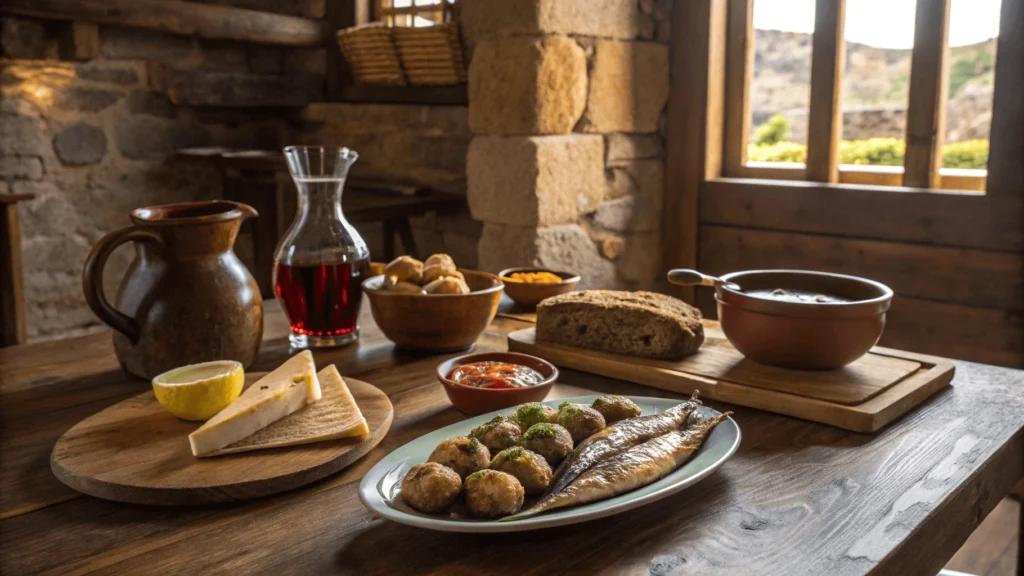
Canarian cuisine combines Spanish traditions with Latin American, African, and local influences.
Canarian Specialties
Papas Arrugadas con Mojo:
- Small “wrinkled” potatoes boiled in sea salt
- Served with red mojo (spicy pepper sauce) and green mojo (herb sauce)
- Found everywhere from guachinches to fine dining
Gofio: “travel to tenerife spain”
- Toasted grain flour (historically a staple food)
- Used in stews, desserts, ice cream, and as a thickener
- Try “escaldón de gofio” – mixed with fish broth
Queso Asado:
- Grilled local cheese with mojo sauces
- Often topped with honey or palm honey
- Best at traditional restaurants
Fresh Fish:
- “Vieja” (parrotfish) – local delicacy
- “Cherne” (wreckfish) – hearty white fish
- “Sama” (sea bream) – delicate flavor
- Usually served simply grilled with garlic and parsley
Other Must-Try Dishes:
- Ropa vieja (shredded meat and chickpea stew)
- Conejo al salmorejo (rabbit in herb sauce)
- Puchero canario (meat and vegetable stew)
- Rancho canario (chickpea and pasta soup)
- Potaje de berros (watercress soup)
Local Wine
Tenerife’s wine industry dates back to the 15th century, using unique grape varieties that survived the phylloxera plague.
Wine Regions:
- Tacoronte-Acentejo: Red wines, oldest designation
- Valle de La Orotava: Unique “cordon trenzado” growing system
- Ycoden-Daute-Isora: Diverse wines, spectacular settings
- Valle de Güímar: White wines, volcanic soils
- Abona: High-altitude vineyards, mineral-rich wines
Key Grape Varieties:
- Listán Negro: Primary red grape variety
- Listán Blanco: Versatile white grape
- Malvasía: Aromatic white used in dessert wines
- Negramoll: Light red similar to Pinot Noir
- Baboso Negro: Premium red variety
Guachinches Explained

These temporary, unofficial restaurants are a unique Tenerife institution.
What to Know:
- Originally places where winemakers sold excess wine
- Basic, authentic food served only to accompany wine
- Family-run in homes, garages, or backyards
- No fixed menu, limited options based on what’s cooked that day
- Cash only, no reservations
- Finding them is part of the adventure (locals or apps can help)
- Best in wine season (November-March)
- Located primarily in La Orotava Valley and Tacoronte
Practical Information & Tips
Budgeting for Tenerife
Costs vary dramatically depending on your travel style.
Accommodation (per night):
- Budget: Hostel dorm (€20-30), Budget apartment (€40-60)
- Mid-range: 3-star hotel (€70-120), Mid-range apartment (€60-100)
- High-end: 4-star hotel (€130-250), Luxury villa (€200-500+)
Food (per person):
- Budget: Self-catering/street food (€15-25/day)
- Mid-range: Local restaurants, occasional hotel meals (€30-50/day)
- High-end: Fine dining, resort restaurants (€60-100+/day)
Transport: “travel to tenerife spain”
- Budget: Public buses (€3-15/day)
- Mid-range: Small rental car (€35-60/day including fuel)
- High-end: Premium rental car or taxis (€70-150/day)
Activities (per person):
- Budget: Free beaches, hiking, self-guided towns (€0-15/day)
- Mid-range: Mix of paid attractions (€20-50/day)
- High-end: Private tours, multiple paid attractions (€60-120+/day)
Sample Total Daily Budgets (per person):
- Budget: €60-90/day
- Mid-range: €120-210/day
- High-end: €250-500+/day
Money-Saving Tips:
- Travel in shoulder season (May/June or September/October)
- Look for “menú del día” fixed-price lunch deals (€10-15)
- Buy a Bono bus card for cheaper public transport
- Consider apartments with kitchens for self-catering
- Drink local wine (much cheaper than imported)
- Limit resort area dining (overpriced and often lower quality)
Safety & Health
Tenerife is generally very safe for tourists, with low crime rates and good healthcare. “travel to tenerife spain”
Sun Protection:
- UV radiation is intense year-round due to latitude
- Use minimum SPF 30, reapply frequently
- Peak sun hours are 11am-3pm
- Consider UPF-rated clothing for long exposure
- Stay hydrated – aim for 2-3 liters of water daily
Hiking Safety: “travel to tenerife spain”
- Tell someone your planned route and return time
- Check weather forecasts – conditions change rapidly on Teide
- Bring proper footwear and equipment
- Carry more water than you think you’ll need
- Download offline maps before remote hikes
- Mountain rescue: 112 (emergency number)
Healthcare Access:
- EU citizens: European Health Insurance Card for public healthcare
- Non-EU: Travel insurance essential
- Private healthcare is excellent but expensive
- Major hospitals in Santa Cruz and South Tenerife
- Pharmacies (farmacias) can help with minor issues
- Emergency number: 112
General Safety: “travel to tenerife spain”
- Crime rates are low, but use common sense
- Watch for pickpockets in crowded tourist areas
- Use hotel safes for valuables
- Be cautious when swimming – respect flag warnings
- Take official taxis, especially at night
Language & Culture
Language:
- Spanish is the official language
- English widely spoken in tourist areas
- German and Italian also common in resorts
- Learning basic Spanish phrases is appreciated

